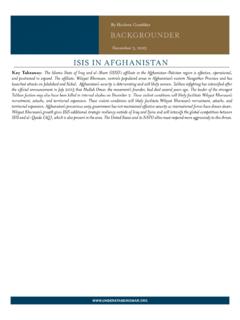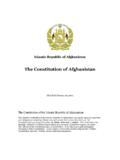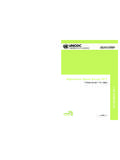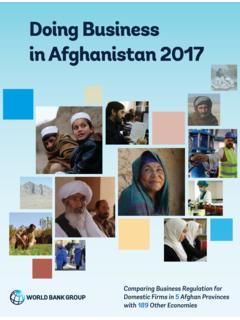Transcription of Recent patterns and trends - United Nations Office …
1 CORRUPTION IN afghanistan :Vienna International Centre, PO Box 500, 1400 Vienna, Austria Tel.: (+43-1) 26060-0, Fax: (+43-1) 26060-5866, 2012 CORRUPTION IN afghanistan :December 2012 Recent patterns and trendsSummary fi ndingsIslamic Republic of AfghanistanHigh Offi ce of Oversight and Anti-Corruption United Nations Office ON DRUGS AND CRIME Vienna CORRUPTION IN afghanistan : Recent patterns AND trends SUMMARY FINDINGS Copyright 2012, United Nations Office on Drugs and Crime Acknowledgments The following organizations and individuals contributed to the implementation of the population survey, four sector-specific integrity surveys of public officials and to the preparation of this report: United Nations Office on Drugs and Crime (Vienna) Sandeep Chawla (Director, Division for Policy Analysis and Public Affairs), Angela Me (Chief, Statistics and Surveys Section-SASS), Enrico Bisogno (Team Leader Crime Statistics, SASS), Michael Jandl (Research Officer, SASS), Felix Reiterer (Consultant, SASS), Mirko Miceli (Intern, SASS), Suzanne Kunnen (Public Information Assistant, Studies and Threat Analysis Section), Jonathan Gibbons (Editor) United Nations Office on Drugs and Crime (Kabul) Jean-Luc Lemahieu (Country Representative), Gary Collins (Programme Manager for Criminal Justice), Sohail Gourwal (National Project Officer) High Office of Oversight and Anti-Corruption Dr.
2 Azizullah Lodin (Chairman), Mohammad Amin Khuramji (Deputy Chairman) The survey fieldwork would not have been possible without the dedicated work of the field managers and surveyors of Eureka Research (Kabul), who often faced difficult security conditions. The implementation of the population survey and the four sector-specific integrity surveys was made possible by a financial contribution from the United Nations Development Programme afghanistan . Disclaimers This report has not been formally edited. The contents of this publication do not necessarily reflect the views or policies of UNODC or contributory organizations and neither do they imply any endorsement. The designations employed and the presentation of material in this publication do not imply the expression of any opinion on the part of UNODC concerning the legal status of any country, territory or city or its authorities, or concerning the delimitation of its frontiers or boundaries.
3 Photos: The pictures are used for illustration only and were not taken in the context of corruption. Alessandro Scotti, Munir , Mohammad Rafi Amini (Director of Policy and Planning Dept) 1 CONTENTS Contents .. 1 3 Key 5 1. Prevalence of 7 2. Public officials and 10 3. Mechanism and impact of bribery in the public 14 4. Recruitment practices in the public sector .. 19 5. Response to bribery by 21 6. Bribes paid to individuals not employed in the public sector of 24 7. Awareness and perception of corruption .. 27 8. Methodological annex .. 30 3 INTRODUCTION Corruption is widely understood to be the improper use of a public or official position for private gain. To strengthen the fight against corruption, the United Nations Convention Against Corruption (UNCAC), which afghanistan ratified in 2008, criminalizes various types of corrupt acts committed by public officials or by individuals working for private-sector entities.
4 Quite apart from specific legal definitions, this includes offences such as bribery, embezzlement, abuse of power and nepotism. A further distinction can be made between political or grand corruption on the one hand and administrative or petty corruption on the other. While the former refers to acts of corruption perpetrated by high-ranking politicians and decision-makers, the latter concerns offences committed by mid- and lower-level public officials who are responsible for administrative procedures and services provided to the public. Political corruption often receives the greatest attention due to its visible impact on political decision-making and good governance, but the pervasive and devastating impact of administrative corruption on the everyday lives of ordinary Afghan citizens receives far less publicity.
5 Yet for the vast majority of the Afghan population, by limiting and distorting their right to access essential public services, hindering their chances of economic development and eroding their trust in government, justice and the rule of law, it is administrative corruption that is most keenly felt. Taking all these different aspects into account, in 2012, as in 2009, the population of afghanistan considered corruption, together with insecurity and unemployment, to be one of the principal challenges facing their country, ahead even of poverty, external influence and the performance of the Government. If during the last three years there have been slight changes in the rating of these issues by the Afghan population, its perceptions of corruption have not improved significantly.
6 Figure 1: Percentage of adult population considering selected issues to be the most important for their country, afghanistan (2009 and 2012) 0%10%20%30%40%50%60%70%Performance of the GovernmentExternal influencePoverty/Low standard of livingUnemploymentCorruptionInsecurity20 092012 Source: General population survey 2009 and general population survey 2012 CORRUPTION IN afghanistan : Recent patterns AND trends 4 This summary report highlights the major findings of a large-scale survey in 2012 on the extent of bribery and other forms of corruption in afghanistan . The research follows up on a previous UNODC corruption survey in 2009 and, using a structurally similar research design, provides comparative results of the extent and patterns of bribery in afghanistan . As in 2009, the survey focuses on the respondents personal experience of bribery, on the modalities, mechanisms and socio-economic patterns of corruption, as well as on perceptions of corruption.
7 In addition to the general population survey, four sector-specific integrity surveys of civil servants were carried out from 2011 to 2012 in the judiciary, police, local government and education sectors,1 with the purpose of identifying particular integrity challenges in public service and shedding light on sector-specific patterns of corruption. 1 As in the 2009 survey, in 2012 more than 6,700 individuals were interviewed across the country in a sample representative of the whole population of afghanistan . In the case of the civil servant surveys, in each sector, 2,000 to 3,000 interviews were conducted with randomly selected service providers and their beneficiaries. CORRUPTION IN afghanistan : Recent patterns AND trends 5 KEY FINDINGS The large-scale population survey on the extent of bribery and four sector-specific integrity surveys of public officials undertaken by UNODC and the Government of afghanistan in 2011/2012 reveal that the delivery of public services remains severely affected by bribery in afghanistan and that bribery has a major impact on the country s economy.
8 In 2012, half of Afghan citizens paid a bribe while requesting a public service and the total cost of bribes paid to public officials amounted to US$ billion. This corresponds to an increase of 40 per cent in real terms between 2009 and 2012, while the ratio of bribery cost to GDP remained relatively constant (23 per cent in 2009; 20 per cent in 2012). While corruption is seen by Afghans as one of the most urgent challenges facing their country, it seems to be increasingly embedded in social practices, with patronage and bribery being an acceptable part of day-to-day life. For example, 68 per cent of citizens interviewed in 2012 considered it acceptable for a civil servant to top up a low salary by accepting small bribes from service users (as opposed to 42 per cent in 2009). Similarly, 67 per cent of citizens considered it sometimes acceptable for a civil servant to be recruited on the basis of family ties and friendship networks (up from 42 per cent in 2009).
9 Since 2009 afghanistan has made some tangible progress in reducing the level of corruption in the public sector. While 59 per cent of the adult population had to pay at least one bribe to a public official in 2009, 50 per cent had to do so in 2012, and whereas 52 per cent of the population paid a bribe to a police officer in 2009, 42 per cent did so in 2012. However, worrying trends have also emerged in the past three years: the frequency of bribery has increased from bribes to bribes per bribe-payer and the average cost of a bribe has risen from US$ 158 to US$ 214, a 29 per cent increase in real terms. Education has emerged as one of the sectors most vulnerable to corruption, with the percentage of those paying a bribe to a teacher jumping from 16 per cent in 2009 to 51 per cent in 2012. In general, there has been no major change in the level of corruption observed in the judiciary, customs service and local authorities, which remained high in 2012, as in 2009.
10 Although with a different intensity, bribery not only affects the public sector but also non-public sector entities in afghanistan . Nearly 30 per cent of Afghan citizens paid a bribe when requesting a service from individuals not employed in the public sector of afghanistan in 2012, as opposed to the 50 per cent who paid bribes to public officials. The national economic impact of non-governmental bribery is also lower, with an estimated total cost of US$ 600 million, some 15 per cent of the estimated US$ billion paid to the public sector. Significant variations in the distribution of these two types of bribery also exist across afghanistan . The public sector is most affected by bribery in the Western (where 71 per cent of the population accessing public services experienced bribery) and North-Eastern Regions (60 per cent), while it is least affected in the Southern (40 per cent) and Central (39 per cent) Regions.

















